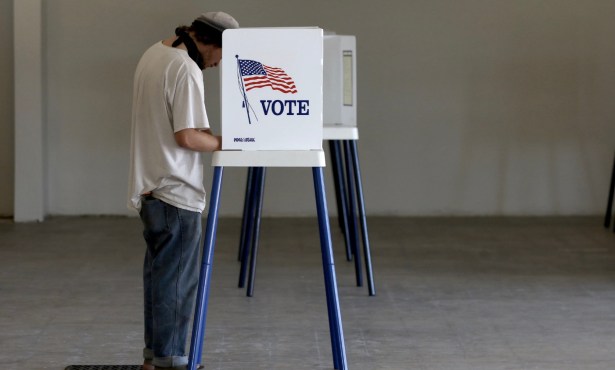Praying to a Porcelain Dog
Everything You Wanted to Know About District Elections but Were Afraid to Ask
UNBECOMING TO WHINE: This Tuesday’s City Council meeting featured a free and frank exchange of excretory fluids between that body’s most ideologically and temperamentally polarized outliers, councilmembers Cathy Murillo on the left and Dale Francisco on the right. That they’ve been seated next to one another indicates only that Mayor Helene Schneider, who orchestrates such arrangements, enjoys a cruelly wicked sense of humor. At issue is the imminent sea change about to shake up City Hall — district elections — and how the council can best cope with the impending seismic shift in how Democracy happens to Santa Barbara. More specifically, the dispute involves the ferociously accelerated public-outreach campaign City Hall finds itself forced to initiate — and finish — by April 16. That’s when City Hall has to convince Judge Donna Geck our election results (only one Latino elected since 2000 and only five since 1973) are not “racially polarized.” To date, no government agency in California has prevailed against such charges. In other words, City Hall is doomed to lose. The key remaining question is how the boundaries will be drawn for the new districts and whether any additional voting reforms can be shoehorned into what threatens to become an outrageously expensive showdown.

For eons, people have complained about the monochromatically pale hue radiating from City Hall. Always, the proposed solution has been to shift to district elections and away from the at-large system we’ve had since 1968. By electing councilmembers from geographic districts, the thinking has been, the council will be more reflective and representative of the community’s true diversity. Candidates running for specific districts, rather than citywide, will find their campaigns cheaper to run; those willing to buck the reigning political machines can better compete. I don’t know if this is true, but it sounds good. Regardless, under state law, district elections are the only surefire legal remedy to racial polarization lawsuits, and late last year, the Frank Banales et al. v. City of Santa Barbara lawsuit was filed. Banales ran for council in 1995 and came in a close fourth out of a field of 12. But there were only three seats. Banales helped get Casa de la Raza off the ground in the ’70s. He got Zona Seca off the ground a few years later. But when Banales ran for council, he was a registered Republican. Fatal flaw. Then as now, Santa Barbara was overwhelmingly Democratic. Had Banales run for a district seat representing the Eastside, we are now told, the precinct results indicate he would have certainly won. Maybe. Maybe not. Behind Banales is Barry Cappello, former city attorney and courtroom gunslinger par excellence. The current council hates district elections for a host of reasons. Why limit yourself to one vote every four years, some ask, when you can vote for three every two? Voters, they insist, should decide. Cappello contends that’s like asking the whites in Selma, Alabama, back in 1964 to hold an election on whether black people should be allowed to vote. Should the case somehow go to trial, City Hall hired the third largest lobby-law firm in Sacramento to take on Cappello. That’s the same crew that got paid $225,000 last year to defeat Measure P and other anti-fracking initiatives, the same ones now leading the charge against the plastic-bag-ban law.
However the titans clash, district elections are all but inevitable. Probably, they’ll be more interesting, more bumpy, more fun, more messy, and more sensitive to neighborhood nuance. But they may not be everything they’re cracked up to be. When Santa Barbara adopted district elections for the first time in 1874, they were a key tool by which the white, Anglo Yankee ascendancy seized control from the Latinos then dominating the city’s political landscape. Because most Latino voters resided in one or two geographical districts, their representation was limited to just one or two council votes under the district scheme. The Yankees — less spatially concentrated — could then control a majority of district seats and call the shots. Fast-forward: No matter how the district boundaries are drawn, district elections will secure at most one or two “safe” Latino seats. But given that Latino students now outnumber whites in the Santa Barbara school district by nearly 2-to-1, why settle for just two? Think of the broader political influence Latino voters could exert in only a few years when this cohort hits voting age. Why, indeed?
Getting back to the public outreach —
required by law before boundaries for the new districts can be drawn — Councilmember Murillo argued Santa Barbarans should also be asked if they support shifting from off-year elections to even years. Voter turnout, it turns out, is dramatically higher in even-year races. Who could possibly be against that? Why not combine the two? Why not, indeed? City Attorney Ariel Calonne nixed that idea — it would make a complicated mess more complicated and messy — pointing out that Cappello never demanded it. If members of the public wanted to bring it up, Calonne said, they could. Murillo argued City Hall should be less passive and pushed for a mushy sounding resolution calling on the council to keep an “open mind” to such a change. Councilmember Francisco — chaps seriously chaffed — replied, “I hope I always have an open mind,” adding with disdain, “I don’t need a motion to take a pledge.” He then dismissed Murillo’s idea as “completely superfluous.” She shot back, “I disagree.” Going for the last word, Francisco sneered under his breath, “Of course you do.” Francisco would insist City Hall had done everything possible to get underrepresented populations to represent themselves. “We could take comfort” in low voter turnout, he said, if they indicate people are satisfied with the status quo. Murillo’s motion, by the way, passed 5-2.
Like they say, it’s all over but the shouting.



